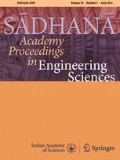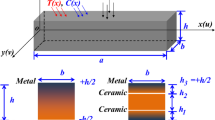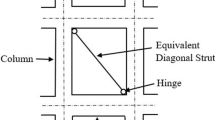Abstract
This study presents an approximate method based on the continuum approach and transfer matrix method for lateral stability analysis of buildings. In this method, the whole structure is idealized as an equivalent sandwich beam which includes all deformations. The effect of shear deformations of walls has been taken into consideration and incorporated in the formulation of the governing equations. Initially the stability differential equation of this equivalent sandwich beam is presented, and then shape functions for each storey is obtained by the solution of the differential equations. By using boundary conditions and stability storey transfer matrices obtained by shape functions, system buckling load can be calculated. To verify the presented method, four numerical examples have been solved. The results of the samples demonstrate the agreement between the presented method and the other methods given in the literature.
Similar content being viewed by others
References
Aristizabal-Ochoa J D 1997 Story stability of braced, partially braced and unbraced frames; Classical approach. ASCE J. Structural Eng. 123(6): 799–807
Aristizabal-Ochoa J D 2002 Classic buckling of three-dimensional multi-column systems under gravity loads. ASCE J. Eng. Mechanics 128(6): 613–624
Aristizabal-Ochoa J D 2003 Elastic stability and second-order analysis of three dimensional frames: Effects of column orientation. ASCE J. Eng. Mechanics 129(11): 1254–1267
Gengshu T, Pi Y L, Bradford A, Tin-Loi F 2008 Buckling and second order effects in dual shear-flexural systems. ASCE J. Struct. Eng. 134(11): 1726–1732
Girgin K, Ozmen G, Orakdogen E 2006 Buckling lengths of irregular frame columns. J. Constructional Steel Res. 62: 605–613
Girgin K, Ozmen G 2007 Simplified procedure for determining buckling loads of three-dimensional framed structures. Eng. Struct. 29(9): 2344–2352
Gomes F C T, Providencia E, Costa P M, Rodrigues J P C, Neves I C 2007 Buckling length of a steel column for fire design. Eng. Struct. 29(10): 2497–2502
Hoenderkamp D C J 2002 Critical loads of lateral load resisting structures for tall buildings. The Structural Design of Tall Buildings 11: 221–232
Inan M 1968 The method of initial values and carry-over matrix in elastomechanics, Middle East Technical University, Publication No. 20, p. 130
Kaveh A, Salimbahrami B 2006 Buckling load of symmetric plane frames using canonical forms. Computers and Struct. 85: 1420–1430
Lee J, Bang M, Kim J Y 2008 An analytical model for high-rise wall-frame structures with outriggers. The Structural Design of Tall and Special Buildings 17(4): 839–851
Mageirou G E, Gantes C J 2006 Buckling strength of multi-story sway, non sway and partially sway frames with semi rigid connections. J. Constructional Res. 62: 893–905
Murashev V, Sigalov E, Baikov V 1972 Design of reinforced concrete structures (Moscow: Mir Publisher)
Pestel E, Leckie F 1963 Matrix methods in elastomechanics (USA: McGraw-Hill) p. 435
Potzta G, Kollar L P 2003 Analysis of building structures by replacement sandwich beams. Int. J. Solids and Structures 40: 535–553
Rosman R 1964 Approximate analysis of shear walls subject to lateral loads. Proceedings of the American Concrete Institute 61(6): 717–734
Rosman R 1974 Stability and dynamics of shear-wall frame structures. Building Science 9: 55–63
Rutenberg A, Levithian I, Decalo M 1988 Stability of shear-wall structures. ASCE J. Structural Division 114(3): 707–716
Stafford Smith B, Crowe E 1986 Estimating periods of vibration of tall buildings. J. Structural Division ASCE 112(5): 1005–1019
Syngellakis S, Kameshki E S 1994 Elastic critical loads for plane frames by transfer matrix method. ASCE J. Structural Division 120(4): 1140–1157
Tong G S, Ji Y 2007 Buckling of frames braced by flexural bracing. J. Constructional Steel Res. 63: 229–236
Xu L, Wang X H 2007 Stability of multi-storey unbraced steel frames subjected to variable loading. J. Constructional Steel Res. 63(10): 1506–1514
Zalka K A 2002 Buckling analysis of buildings braced by frameworks, shear walls and cores. The Structural Design of Tall Buildings 11: 197–219
Zalka K A 2003 A hand method for predicting the stability of regular buildings, using frequency measurements. The Structural Design of Tall and Special Buildings 12: 273–281
Author information
Authors and Affiliations
Corresponding author
Rights and permissions
About this article
Cite this article
Bozdogan, K.B., Ozturk, D. An approximate method for lateral stability analysis of wall-frame buildings including shear deformations of walls. Sadhana 35, 241–253 (2010). https://doi.org/10.1007/s12046-010-0008-y
Received:
Revised:
Accepted:
Published:
Issue Date:
DOI: https://doi.org/10.1007/s12046-010-0008-y




